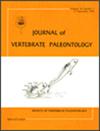标题印度上三叠世一新clevosaurus(鳞龙目:舌头龙目)
IF 1.9
4区 地球科学
Q2 PALEONTOLOGY
引用次数: 0
摘要
本文章由计算机程序翻译,如有差异,请以英文原文为准。
A new clevosaurid (Lepidosauria: Rhynchocephalia) from the Upper Triassic of India
ABSTRACT A new clevosaurid rhynchocephalian is described from the Upper Triassic Tiki Formation of the Rewa Gondwana Basin of India. The material is based on several partial craniomandibular elements containing acrodont and fully ankylosed tooth implantations and on the basis of multiple diagnostic features is assigned to a new taxon, Clevosaurus nicholasi. Phylogenetic analysis nests the Tiki rhynchocephalian within the clade Clevosauridae, where it is recovered as an early-diverging taxon basal to the other clevosaurs except for a clade comprising C. convallis + Sigmala sigmala. The autapomorphic characters of Clevosaurus nicholasi include a very robust dentary with an obliquely angled narrow lip of the secondary bone at the symphysis, anteriorly bifurcated Meckelian canal, a sub-dental shelf on the dentary, acrodont marginal anterior teeth, and absence of or smooth lateral and medial wear facets on the marginal dentary and maxillary teeth, respectively. The Late Triassic rhynchocephalian record of the Gondwana is relatively sparse in comparison with that of the Laurasian regions, and the new clevosaur represents the first Late Triassic record from India. Based on the paleobiogeographic distribution, a possible Gondwanan origin for Clevosauridae is hypothesized.
求助全文
通过发布文献求助,成功后即可免费获取论文全文。
去求助
来源期刊
CiteScore
2.90
自引率
7.10%
发文量
58
审稿时长
4-8 weeks
期刊介绍:
The Journal of Vertebrate Paleontology publishes original contributions on all aspects of vertebrate paleobiology, including vertebrate origins, evolution, functional morphology, taxonomy, biostratigraphy, phylogenetics, paleoecology, paleobiogeography, and paleoanthropology. JVP publishes high quality peer-reviewed original articles, occasional reviews, and interdisciplinary papers. It is international in scope, and emphasizes both specimen- and field-based based research and the use of high-quality illustrations. Priority is given to articles dealing with topics of broad interest to the entire vertebrate paleontology community and to high-impact specialist studies. Articles dealing with narrower topics, including notes on taxonomic name changes (unless these deal with errors published in JVP), preliminary site reports, and documentation of new specimens of well-known taxa, are afforded lower priority.

 求助内容:
求助内容: 应助结果提醒方式:
应助结果提醒方式:


